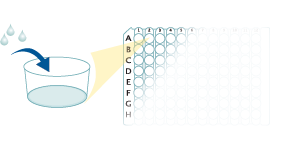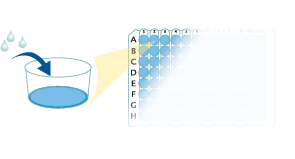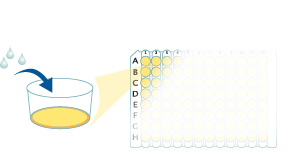Human CXCL1/GRO alpha Quantikine ELISA Kit Summary
Product Summary
Precision
Cell Culture Supernates
| Intra-Assay Precision | Inter-Assay Precision | |||||
|---|---|---|---|---|---|---|
| Sample | 1 | 2 | 3 | 1 | 2 | 3 |
| n | 20 | 20 | 20 | 20 | 20 | 20 |
| Mean (pg/mL) | 81.4 | 318 | 734 | 87.4 | 320 | 758 |
| Standard Deviation | 3.7 | 7.4 | 55 | 11.9 | 27.6 | 62.7 |
| CV% | 4.5 | 2.3 | 7.5 | 13.6 | 8.6 | 8.3 |
Serum, EDTA Plasma, Heparin Plasma, Citrate Plasma
| Intra-Assay Precision | Inter-Assay Precision | |||||
|---|---|---|---|---|---|---|
| Sample | 1 | 2 | 3 | 1 | 2 | 3 |
| n | 20 | 20 | 20 | 20 | 20 | 20 |
| Mean (pg/mL) | 61.4 | 251 | 736 | 62.8 | 252 | 734 |
| Standard Deviation | 2.2 | 6 | 20 | 3.6 | 11.9 | 38.9 |
| CV% | 3.6 | 2.4 | 2.7 | 5.7 | 4.7 | 5.3 |
Recovery
The recovery of human GRO alpha spiked to levels throughout the range of the assay in various matrices was evaluated.
| Sample Type | Average % Recovery | Range % |
|---|---|---|
| Cell Culture Media (n=4) | 97 | 81-108 |
| Citrate Plasma (n=10) | 90 | 80-98 |
| EDTA Plasma (n=10) | 93 | 86-102 |
| Heparin Plasma (n=10) | 95 | 83-109 |
| Serum (n=10) | 98 | 87-108 |
Linearity
Scientific Data
Product Datasheets
Preparation and Storage
Background: CXCL1/GRO alpha/KC/CINC-1
CXCL1/GRO alpha, also known as KC in mouse and CINC-1 in rat, is a member of the CXC family of chemokines. Human CXCL1/GRO alpha is 107 amino acids (aa) in length with a predicted molecular weight of 11 kDa. The mouse and rat orthologs share 57% and 59% amino acid sequence identity with the human protein, respectively. Genome-wide analysis suggests that the protein encoded by the mouse Cxcl3 gene is homologous to human CXCL1/GRO alpha protein. Human CXCL1/GRO alpha can be cleaved into three isoforms CXCL1/GRO alpha (aa 4-73), CXCL1/GRO alpha (aa 5-73), and CXCL1/GRO alpha (aa 6-73) which show higher activity than the full length protein. CXCL1/GRO alpha is secreted by mast cells and macrophages whereupon it acts as a chemoattractant for neutrophils.
Assay Procedure
Refer to the product- Prepare all reagents, standard dilutions, and samples as directed in the product insert.
- Remove excess microplate strips from the plate frame, return them to the foil pouch containing the desiccant pack, and reseal.
- For Serum & Plasma Samples Only: Add 50 µL of Assay Diluent to each well.
- Add 200 µL of Standard, control, or sample to each well.
- For Serum & Plasma Samples: Cover with a plate sealer, and incubate at room temperature for 2 hours.
For Cell Culture Supernate Samples: Cover with a plate sealer, and incubate at room temperature for 1.5 hours. - Aspirate each well and wash, repeating the process twice for a total of 3 washes.
- Add 200 µL of Conjugate to each well.
- For Serum & Plasma Samples: Cover with a new plate sealer, and incubate at 2-8 °C for 2 hours.
For Cell Culture Supernate Samples: Cover with a new plate sealer, and incubate at 2-8 °C for 1 hour. - Aspirate and wash 3 times.
- Add 200 µL Substrate Solution to each well.
- For Serum & Plasma Samples: Incubate at room temperature for 30 minutes. PROTECT FROM LIGHT.
For Cell Culture Supernate Samples: Incubate at room temperature for 15 minutes. PROTECT FROM LIGHT. - Add 50 µL of Stop Solution to each well. Read at 450 nm within 30 minutes. Set wavelength correction to 540 nm or 570 nm.





Citations for Human CXCL1/GRO alpha Quantikine ELISA Kit
R&D Systems personnel manually curate a database that contains references using R&D Systems products. The data collected includes not only links to publications in PubMed, but also provides information about sample types, species, and experimental conditions.
47
Citations: Showing 1 - 10
Filter your results:
Filter by:
-
Selective inhibition of HDAC6 promotes bladder cancer radiosensitization and mitigates the radiation-induced CXCL1 signalling
Authors: YC Tsai, TY Wang, CL Hsu, WC Lin, JY Chen, JH Li, YS Pu, AL Cheng, JC Cheng, SF Su
British Journal of Cancer, 2023-02-21;0(0):.
Species: Human
Sample Types: Cell Culture Supernates
-
Canonical NF-kappaB signaling pathway and GRO-alpha/CXCR2 axis are activated in unruptured intracranial aneurysm patients
Authors: J Kami?ska, M Tylicka, V Dymicka-Pi, Z Mariak, J Matowicka-, OM Koper-Lenk
Scientific Reports, 2022-12-09;12(1):21375.
Species: Human
Sample Types: Serum
-
MiR-182-3p targets TRF2 and impairs tumor growth of triple-negative breast cancer
Authors: R Dinami, L Pompili, E Petti, M Porru, C D'Angelo, S Di Vito, A Rizzo, V Campani, G De Rosa, A Bruna, V Serra, M Mano, M Giacca, C Leonetti, G Ciliberto, M Tarsounas, A Stoppaccia, S Schoeftner, A Biroccio
Embo Molecular Medicine, 2022-11-25;0(0):e16033.
Species: Human
Sample Types: Cell Culture Supernates
-
Proof-of-Principle Study Suggesting Potential Anti-Inflammatory Activity of Butyrate and Propionate in Periodontal Cells
Authors: AFP Santos, LCC Cervantes, L Panahipour, FÁ Souza, R Gruber
International Journal of Molecular Sciences, 2022-09-20;23(19):.
Species: Human
Sample Types: Cell Culture Supernates
-
Senescent Human Pancreatic Stellate Cells Secrete CXCR2 Agonist CXCLs to Promote Proliferation and Migration of Human Pancreatic Cancer AsPC-1 and MIAPaCa-2 Cell Lines
Authors: T Takikawa, S Hamada, R Matsumoto, Y Tanaka, F Kataoka, A Sasaki, A Masamune
International Journal of Molecular Sciences, 2022-08-17;23(16):.
Species: Human
Sample Types: Cell Culture Supernates
-
CXCL1-CXCR2 signalling mediates hypertensive retinopathy by inducing macrophage infiltration
Authors: S Wang, J Bai, YL Zhang, QY Lin, X Han, WK Qu, PF Zhang, YS Ge, Q Zhao, HH Li
Redox Biology, 2022-08-13;56(0):102438.
Species: Human
Sample Types: Serum
-
KIF4A promotes tumor progression of bladder cancer via CXCL5 dependent myeloid-derived suppressor cells recruitment
Authors: N Lin, L Chen, Y Zhang, Y Yang, L Zhang, L Chen, P Zhang, H Su, M Yin
Scientific Reports, 2022-04-10;12(1):6015.
Species: Human
Sample Types: Cell Culture Supernates
-
Efficacy of chitinase-3-like protein 1 as an in�vivo bone formation predictable marker of maxillary/mandibular bone marrow stromal cells
Authors: N Komabashir, F Suehiro, M Ishii, M Nishimura
Regenerative Therapy, 2021-03-27;18(0):38-50.
Species: Human
Sample Types: Cell Culture Supernates
-
Visfatin Enhances Breast Cancer Progression through CXCL1 Induction in Tumor-Associated Macrophages
Authors: YY Wang, HD Chen, S Lo, YK Chen, YC Huang, SC Hu, YC Hsieh, AC Hung, MF Hou, SF Yuan
Cancers, 2020-11-26;12(12):.
Species: Human
Sample Types: Cell Culture Supernates
-
Monoclonal Antibody against CXCL1 (HL2401) as a Novel Agent in Suppressing IL6 Expression and Tumoral Growth
Authors: M Miyake, H Furuya, S Onishi, K Hokutan, S Anai, O Chan, S Shi, K Fujimoto, S Goodison, W Cai, CJ Rosser
Theranostics, 2019-01-25;9(3):853-867.
Species: Human
Sample Types: Cell Culture Supernates
-
The intrathecal expression and pathogenetic role of Th17 cytokines and CXCR2-binding chemokines in tick-borne encephalitis
Authors: S Grygorczuk, R ?wierzbi?s, M Kondrusik, J Dunaj, P Czupryna, A Moniuszko, A Siemieniak, S Pancewicz
J Neuroinflammation, 2018-04-20;15(1):115.
Species: Human
Sample Types: Serum
-
Inflammatory cytokine production in tumor cells upon chemotherapy drug exposure or upon selection for drug resistance
Authors: DW Edwardson, J Boudreau, J Mapletoft, C Lanner, AT Kovala, AM Parissenti
PLoS ONE, 2017-09-15;12(9):e0183662.
Species: Human
Sample Types: Cell Culture Supernates
-
CAF-secreted CXCL1 conferred radioresistance by regulating DNA damage response in a ROS-dependent manner in esophageal squamous cell carcinoma
Authors: H Zhang, J Yue, Z Jiang, R Zhou, R Xie, Y Xu, S Wu
Cell Death Dis, 2017-05-18;8(5):e2790.
Species: Human
Sample Types: Cell Culture Supernates
-
CXCL1 is critical for pre-metastatic niche formation and metastasis in colorectal cancer
Authors: D Wang, H Sun, J Wei, B Cen, RN DuBois
Cancer Res., 2017-04-28;0(0):.
Species: Mouse
Sample Types: Cell Culture Supernates
-
MicroRNAs regulate cytokine responses in gingival epithelial cells
Infect Immun, 2016-11-18;0(0):.
Species: Human
Sample Types: Cell Culture Supernates
-
High salt primes a specific activation state of macrophages, M(Na).
Authors: Zhang W, Zheng X, DU L, Sun J, Shen Z, Shi C, Sun S, Zhang Z, Chen X, Qin M, Liu X, Tao J, Jia L, Fan H, Zhou B, Yu Y, Ying H, Hui L, Liu X, Yi X, Liu X, Zhang L, Duan S
Cell Res, 2015-07-24;25(8):893-910.
Species: Human
Sample Types: Cell Culture Supernates
-
High EMT Signature Score of Invasive Non-Small Cell Lung Cancer (NSCLC) Cells Correlates with NFkappaB Driven Colony-Stimulating Factor 2 (CSF2/GM-CSF) Secretion by Neighboring Stromal Fibroblasts.
Authors: Rudisch A, Dewhurst M, Horga L, Kramer N, Harrer N, Dong M, van der Kuip H, Wernitznig A, Bernthaler A, Dolznig H, Sommergruber W
PLoS ONE, 2015-04-28;10(4):e0124283.
Species: Human
Sample Types: Cell Culture Supernates
-
Stromal cells positively and negatively modulate the growth of cancer cells: stimulation via the PGE2-TNFalpha-IL-6 pathway and inhibition via secreted GAPDH-E-cadherin interaction.
Authors: Kawada M, Inoue H, Ohba S, Yoshida J, Masuda T, Yamasaki M, Usami I, Sakamoto S, Abe H, Watanabe T, Yamori T, Shibasaki M, Nomoto A
PLoS ONE, 2015-03-18;10(3):e0119415.
Species: Human
Sample Types: Cell Culture Supernates
-
p53 and NF-kappaB coregulate proinflammatory gene responses in human macrophages.
Authors: Lowe J, Menendez D, Bushel P, Shatz M, Kirk E, Troester M, Garantziotis S, Fessler M, Resnick M
Cancer Res, 2014-04-15;74(8):2182-92.
Species: Human
Sample Types: Cell Culture Supernates
-
Targeted gene silencing using a follicle-stimulating hormone peptide-conjugated nanoparticle system improves its specificity and efficacy in ovarian clear cell carcinoma in vitro.
Authors: Hong S, Zhang X, Chen J, Zhou J, Zheng Y, Xu C
J Ovarian Res, 2013-11-20;6(1):80.
Species: Human
Sample Types: Cell Culture Supernates
-
Influence of the CXCL1 rs4074 A allele on alcohol induced cirrhosis and HCC in patients of European descent.
Authors: Nischalke H, Berger C, Lutz P, Langhans B, Wolter F, Eisenhardt M, Kramer B, Kokordelis P, Glassner A, Muller T, Rosendahl J, Fischer J, Berg T, Grunhage F, Leifeld L, Soyka M, Nattermann J, Sauerbruch T, Stickel F, Spengler U
PLoS ONE, 2013-11-18;8(11):e80848.
Species: Human
Sample Types: Cell Culture Supernates
-
Phosphoinositide 3-kinase inhibition restores neutrophil accuracy in the elderly: toward targeted treatments for immunosenescence.
Authors: Sapey E, Greenwood H, Walton G, Mann E, Love A, Aaronson N, Insall R, Stockley R, Lord J
Blood, 2013-11-04;123(2):239-48.
Species: Human
Sample Types: Sputum
-
Circulating levels of transforming growth factor-betaeta (TGF-beta) and chemokine (C-X-C motif) ligand-1 (CXCL1) as predictors of distant seeding of circulating tumor cells in patients with metastatic breast cancer.
Authors: Divella R, Daniele A, Savino E, Palma F, Bellizzi A, Giotta F, Simone G, Lioce M, Quaranta M, Paradiso A, Mazzocca A
Anticancer Res, 2013-04-01;33(4):1491-7.
Species: Human
Sample Types: Plasma
-
Role of interleukin-32 in Helicobacter pylori-induced gastric inflammation.
Authors: Sakitani K, Hirata Y, Hayakawa Y, Serizawa T, Nakata W, Takahashi R, Kinoshita H, Sakamoto K, Nakagawa H, Akanuma M, Yoshida H, Maeda S, Koike K
Infect Immun, 2012-08-13;80(11):3795-803.
Species: Human
Sample Types: Cell Lysates
-
CXCR2 promotes ovarian cancer growth through dysregulated cell cycle, diminished apoptosis, and enhanced angiogenesis.
Authors: Yang G, Rosen DG, Liu G
Clin. Cancer Res., 2010-05-26;16(15):3875-86.
Species: Human
Sample Types: Cell Culture Supernates
-
A phase I trial of bortezomib with temozolomide in patients with advanced melanoma: toxicities, antitumor effects, and modulation of therapeutic targets.
Authors: Su Y, Amiri KI, Horton LW
Clin. Cancer Res., 2009-12-22;16(1):348-57.
Species: Human
Sample Types: Serum
-
Immunomodulation of nasal epithelial cells by Staphylococcus aureus-derived serine proteases.
Authors: Rudack C, Sachse F, Albert N, Becker K, von Eiff C
J. Immunol., 2009-11-16;183(11):7592-601.
Species: Human
Sample Types: Cell Culture Supernates
-
Thymic stromal lymphopoietin induces chemotactic and prosurvival effects in eosinophils: implications in allergic inflammation.
Authors: Wong CK, Hu S, Cheung PF
Am. J. Respir. Cell Mol. Biol., 2009-10-20;43(3):305-15.
Species: Human
Sample Types: Cell Culture Supernates
-
LPS induces GROalpha chemokine production via NF-kappaB in oral fibroblasts.
Authors: Jonsson D, Amisten S, Bratthall G, Holm A, Nilsson BO
Inflamm. Res., 2009-05-09;58(11):791-6.
Species: Human
Sample Types: Cell Culture Supernates
-
Dysregulation of stromal derived factor 1/CXCR4 axis in the megakaryocytic lineage in essential thrombocythemia.
Authors: Salim JP, Goette NP, Lev PR, Chazarreta CD, Heller PG, Alvarez C, Molinas FC, Marta RF
Br. J. Haematol., 2008-11-01;144(1):69-77.
Species: Human
Sample Types: Plasma
-
The human IL-17F/IL-17A heterodimeric cytokine signals through the IL-17RA/IL-17RC receptor complex.
Authors: Wright JF, Bennett F, Li B, Brooks J, Luxenberg DP, Whitters MJ, Tomkinson KN, Fitz LJ, Wolfman NM, Collins M, Dunussi-Joannopoulos K, Chatterjee-Kishore M, Carreno BM
J. Immunol., 2008-08-15;181(4):2799-805.
Species: Human
Sample Types: Cell Culture Supernates
-
IL-8 as antibody therapeutic target in inflammatory diseases: reduction of clinical activity in palmoplantar pustulosis.
Authors: Skov L, Beurskens FJ, Zachariae CO, Reitamo S, Teeling J, Satijn D, Knudsen KM, Boot EP, Hudson D, Baadsgaard O, Parren PW, van de Winkel JG
J. Immunol., 2008-07-01;181(1):669-79.
Species: Human
Sample Types: Complex Sample Type
-
CT20126, a novel immunosuppressant, prevents collagen-induced arthritis through the down-regulation of inflammatory gene expression by inhibiting NF-kappaB activation.
Authors: Lee SJ, Nam WD, Na HJ, Cho YL, Ha KS, Hwang JY, Lee H, Kim SO, Kwon YG, Kim YM
Biochem. Pharmacol., 2008-04-18;76(1):79-90.
Species: Human
Sample Types: Cell Culture Supernates
-
MMP-12 induces IL-8/CXCL8 secretion through EGFR and ERK1/2 activation in epithelial cells.
Authors: Le Quement C, Guenon I, Gillon JY, Lagente V, Boichot E
Am. J. Physiol. Lung Cell Mol. Physiol., 2008-04-04;294(6):L1076-84.
Species: Human
Sample Types: Cell Culture Supernates
-
A potential role of the CXC chemokine GROalpha in atherosclerosis and plaque destabilization: downregulatory effects of statins.
Authors: Breland UM, Halvorsen B, Hol J, ØIe E, Paulsson-Berne G, Yndestad A, Smith C, Otterdal K, Hedin U, Waehre T, Sandberg WJ, Froland SS, Haraldsen G, Gullestad L, Damas JK, Hansson GK, Aukrust P
Arterioscler. Thromb. Vasc. Biol., 2008-02-14;28(5):1005-11.
Species: Human
Sample Types: Plasma
-
Duffy antigen modifies the chemokine response in human endotoxemia.
Authors: Mayr FB, Spiel AO, Leitner JM, Firbas C, Kliegel T, Jilma-Stohlawetz P, Derendorf H, Jilma B
Crit. Care Med., 2008-01-01;36(1):159-65.
Species: Human
Sample Types: Plasma
-
Th1/Th2 cytokines reciprocally regulate in vitro pulmonary angiogenesis via CXC chemokine synthesis.
Authors: Matsuda A, Fukuda S, Matsumoto K, Saito H
Am. J. Respir. Cell Mol. Biol., 2007-08-20;38(2):168-75.
Species: Human
Sample Types: Cell Culture Supernates
-
Proliferation, differentiation, and cytokine secretion of human umbilical cord blood-derived mononuclear cells in vitro.
Authors: Neuhoff S, Moers J, Rieks M, Grunwald T, Jensen A, Dermietzel R, Meier C
Exp. Hematol., 2007-07-01;35(7):1119-31.
Species: Human
Sample Types: Cell Culture Supernates
-
Role of interleukin-8 and growth-regulated oncogene-alpha in the chemotactic migration of all-trans retinoic acid-treated promyelocytic leukemic cells toward alveolar epithelial cells.
Authors: Tsai WH, Hsu HC, Lin CC, Ho CK, Kou YR
Crit. Care Med., 2007-03-01;35(3):879-85.
Species: Human
Sample Types: Cell Culture Supernates
-
An essential role for IL-17 in preventing pathogen-initiated bone destruction: recruitment of neutrophils to inflamed bone requires IL-17 receptor-dependent signals.
Authors: Yu JJ, Ruddy MJ, Wong GC, Sfintescu C, Baker PJ, Smith JB, Evans RT, Gaffen SL
Blood, 2007-01-03;109(9):3794-802.
Species: Mouse
Sample Types: Serum
-
L5, the most electronegative subfraction of plasma LDL, induces endothelial vascular cell adhesion molecule 1 and CXC chemokines, which mediate mononuclear leukocyte adhesion.
Authors: Abe Y, Fornage M, Yang CY, Bui-Thanh NA, Wise V, Chen HH, Rangaraj G, Ballantyne CM
Atherosclerosis, 2006-10-04;192(1):56-66.
Species: Human
Sample Types: Cell Culture Supernates
-
Different angiogenic activity in pulmonary sarcoidosis and idiopathic pulmonary fibrosis.
Authors: Antoniou KM, Tzouvelekis A, Alexandrakis MG, Sfiridaki K, Tsiligianni I, Rachiotis G, Tzanakis N, Bouros D, Milic-Emili J, Siafakas NM
Chest, 2006-10-01;130(4):982-8.
Species: Human
Sample Types: BALF
-
IL-17 enhances the net angiogenic activity and in vivo growth of human non-small cell lung cancer in SCID mice through promoting CXCR-2-dependent angiogenesis.
Authors: Numasaki M, Watanabe M, Suzuki T, Takahashi H, Nakamura A, McAllister F, Hishinuma T, Goto J, Lotze MT, Kolls JK, Sasaki H
J. Immunol., 2005-11-01;175(9):6177-89.
Species: Human
Sample Types: Cell Culture Supernates
-
Exhaled breath condensate levels of 8-isoprostane, growth related oncogene alpha and monocyte chemoattractant protein-1 in patients with chronic obstructive pulmonary disease.
Authors: Ko FW, Lau CY, Leung TF, Wong GW, Lam CW, Hui DS
Respir Med, 2005-10-06;100(4):630-8.
Species: Human
Sample Types: Exhaled Breath Condensate (EBC)
-
ELR+ CXC chemokines in human milk.
Authors: Maheshwari A, Christensen RD, Calhoun DA
Cytokine, 2003-11-07;24(3):91-102.
Species: Human
Sample Types: Serum
-
TNFalpha-induced macrophage chemokine secretion is more dependent on NF-kappaB expression than lipopolysaccharides-induced macrophage chemokine secretion.
Authors: Ciesielski CJ, Andreakos E, Foxwell BM, Feldmann M
Eur. J. Immunol., 2002-07-01;32(7):2037-45.
Species: Human
Sample Types: Cell Culture Supernates
-
Il-6 and its soluble receptor orchestrate a temporal switch in the pattern of leukocyte recruitment seen during acute inflammation.
Authors: Hurst SM, Wilkinson TS, McLoughlin RM, Jones S, Horiuchi S, Yamamoto N, Rose-John S, Fuller GM, Topley N, Jones SA
Immunity, 2001-06-01;14(6):705-14.
Species: Human
Sample Types: Cell Culture Supernates
FAQs
No product specific FAQs exist for this product, however you may
View all ELISA FAQsReviews for Human CXCL1/GRO alpha Quantikine ELISA Kit
Average Rating: 5 (Based on 1 Review)
Have you used Human CXCL1/GRO alpha Quantikine ELISA Kit?
Submit a review and receive an Amazon gift card.
$25/€18/£15/$25CAN/¥75 Yuan/¥2500 Yen for a review with an image
$10/€7/£6/$10 CAD/¥70 Yuan/¥1110 Yen for a review without an image
Filter by:









